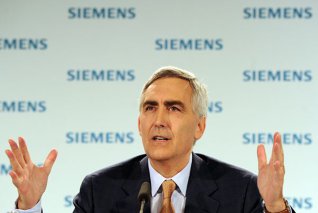Peter Loescher, chairman and chief executive officer of Siemens, believes that despite the growth of the green power sector, coal and natural gas will be used for a significant part of energy production for a long time.
Loescher’s vision of the energy mix is a new warning signal for the local market, which might find itself short on electricity generation facilities as 80% of the thermoelectric power plants in operation at the moment are past their life cycle.
Even though about 1,000 MW of wind farms were up and running at the end of last year, their production capacity is extremely volatile and at times they operate at a small fraction of the capacity installed. Power generation in Romania is still reliant on forty-year old thermoelectric plants or on hydropower plants built before 1989. The only investments the government has made in the two decades ever since are the two nuclear reactors in Cernavoda.
Despite this, there are hardly any investments in major projects to generate electricity from coal or natural gas. Only one 860 MW power plant running on gas, whose capacity is higher than a Cernavoda reactor’s was built by Petrom after a EUR500 million investment. All the other projects for new thermoelectric power plants that should generate electricity using coal have been frozen in place by red tape for years, although bituminous coal and lignite are Romania’s most important resource, enough to last several hundred years.
Loescher explains that although it is necessary to expand renewable energy production capacity, wind and solar power cannot replace everything else on short term. Clean high efficiency thermoelectric power plants running on coal or natural gas will be vital for a long time to have a sure energy source.
The problem, at least for the local market, is that many of the large foreign energy companies operating on it have not joined forces with the government for major projects such as the reactors 3 and 4 of the nuclear plant in Cernavoda (SE Romania) worth EUR4 billion or the one billion euro hydropower plant Tarnita Lapusesti (NW Romania).
The energy industry heavyweights said they were reluctant to invest because of the uncertainties surrounding the restructuring of the local energy system and especially because of the still not deregulated electricity and gas prices. Early this week, however, the World Bank strongly urged them to show the courage to become involved in big investment projects while there was still time because Romania would conduct the reforms they demand, anyway.
As for the state of the economy in Europe, which in turn makes a strong impact on the investment appetite of major companies, Siemens’ CEO says that the risks of the region remain significant, especially when considering the situation of Greece and Spain.
The global economy seems to be moving in a more stable direction, but beyond that there are still unresolved risks, as countries like Spain and Greece are still facing tremendous challenges, said Loescher. On the other hand, emerging countries, first of all China and India, remain the stabilizing factors of the world economy, he added.
Loescher said the group has about 1,800 people working in the five production facilities and nine regional service and sales centers in Romania.
Asked whether Siemens might focus on making wind turbines in Romania, Loescher said it maintained a close relationship with local customers and had no concrete plans thereof for the time being.
Siemens revenue stands at EUR73.5 billion. The group employs 360,000 people.
Sources: ZF
(English version by Loredana Fratila-Cristescu)
